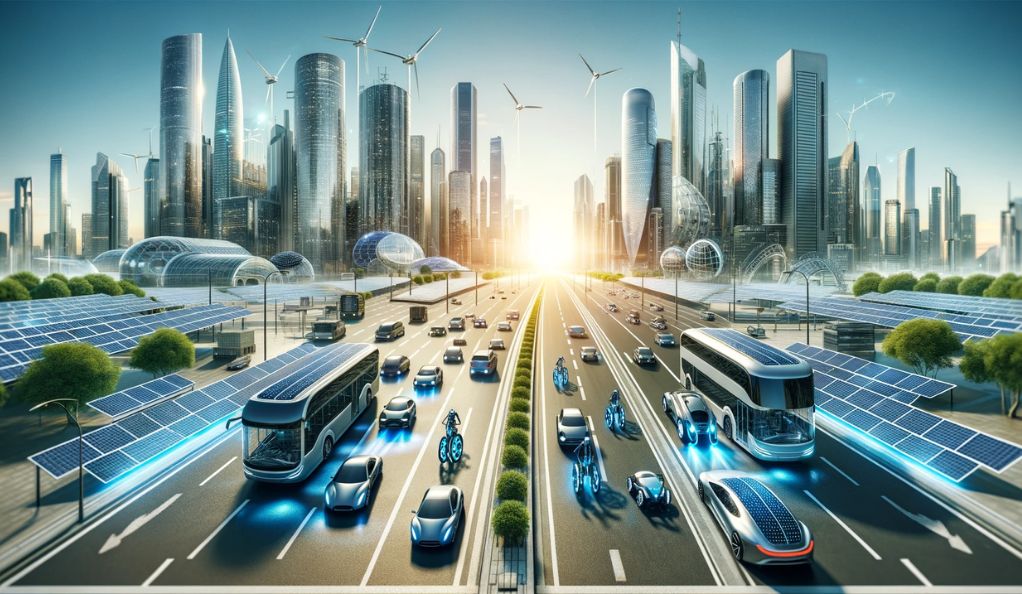The quest for sustainable transportation solutions has led to an increasing focus on solar energy, a clean and renewable source that holds immense potential for powering our mobility needs. In this section, we explore the role of solar energy in transportation, tracing its evolution and considering its growing significance in our journey towards a greener, more sustainable future.
The Emergence of Solar Energy in Transportation
Solar energy’s foray into transportation began with small-scale applications, such as solar-powered lights and battery chargers. However, recent technological advancements have significantly expanded its scope. Today, solar energy is not just an auxiliary power source but a primary driver for various modes of transport. This shift is largely due to the advancements in photovoltaic (PV) cell technology, which have made solar panels more efficient and cost-effective.
The Evolution of Solar-Powered Vehicles
The evolution of solar-powered vehicles has been remarkable. From the first solar-powered cars, which were primarily experimental prototypes, to the latest models equipped with high-efficiency solar cells, the journey has been transformative. These vehicles are no longer constrained to short distances or low speeds; modern solar-powered cars boast impressive ranges and speeds, making them viable for everyday use.
The Role of Solar Energy in Public Transit
Public transportation systems around the world are increasingly adopting solar energy. Electric buses and trains powered by solar energy offer a cleaner alternative to traditional diesel-powered vehicles. Cities are installing solar panels at transit stations and depots, harnessing the sun’s energy to power everything from lighting to the vehicles themselves. This shift not only reduces the carbon footprint of public transit but also enhances energy independence.
Solar Energy and Logistics
In the realm of logistics and freight transport, solar energy is making inroads as well. Warehouses and distribution centers are utilizing solar panels to reduce their reliance on grid electricity. Furthermore, some logistics companies are experimenting with solar-powered delivery vehicles, which promise to reduce emissions and operational costs.
The Intersection of Technology and Sustainability
The integration of solar energy into transportation is a shining example of how technology can drive sustainability. As solar panel efficiency continues to improve and costs decrease, we can expect solar energy to play an increasingly central role in powering our transportation needs. This transition not only represents a technological breakthrough but also aligns with global efforts to combat climate change and promote environmental stewardship.
The Driving Force Behind Solar-Powered Transportation

Remarkable advancements in solar panel efficiency and battery technology have propelled the feasibility and practicality of solar-powered transportation, offering a sustainable and eco-friendly mode of travel.
Advancements in Solar Panel Efficiency
The core of solar-powered transportation lies in the efficiency of solar panels. Over the past decade, significant strides have been made in photovoltaic (PV) cell technology, leading to solar panels that are not only more efficient but also more practical for use in vehicles.
- High-Efficiency Solar Cells: Perovskite cells offer higher energy conversion, boosting power generation from the same surface area, making solar transportation more viable.
- Flexible, Lightweight Panels: Innovative lightweight panels integrate seamlessly into vehicles, maintaining efficiency and aerodynamics.
- Durable, Multi-Purpose Panels: Modern panels are resilient and serve multiple purposes, powering both propulsion and onboard systems in solar vehicles.
Innovations in Solar Battery Storage and Electric Vehicles
The second pillar of solar-powered transportation is the battery technology used for energy storage. The effectiveness of solar energy in transportation heavily depends on how efficiently this energy can be stored and used.
- Advanced Battery Technologies: Recent breakthroughs in batteries, like solid-state and lithium-sulfur, offer higher energy density and longer life cycles, enabling solar-powered vehicles to cover longer distances with fewer charges.
- Integration with Electric Vehicles: EVs’ popularity has revolutionized solar transportation. Solar panels extend their range, either built-in or portable, addressing traditional EV range limitations.
- Smart Energy Management: Solar vehicles incorporate intelligent systems optimizing energy usage based on speed, route, and needs, enhancing practicality for daily use.
- Rapid Charging Technology: Widespread solar-powered rapid charging stations reduce vehicle downtime, enhancing user convenience and solar energy adoption.
Solar Energy in Public Transportation: Buses and Trains
The integration of solar energy into public transportation has been a significant step towards sustainability. Solar-powered buses and trains are increasingly being piloted and adopted around the world. Here are some notable case studies:
- China’s Solar Bus Project: Solar buses in Zhengzhou, China, use rooftop panels to power electronics and extend range, reducing grid energy consumption.
- India’s Solar Trains: Indian Railways employs train roof solar panels for lighting and fans, reducing diesel generator reliance.
- San Francisco’s Solar Light Rail: San Francisco’s light rail system partially runs on energy from solar panels atop stations, demonstrating integrated solar usage in public transport.
- Adelaide’s Tindo Bus: Adelaide, Australia boasts the world’s first solar-powered electric bus, the Tindo, exclusively powered by solar panels at the bus station.
Benefits of Implementing Solar Energy in Public Transport
- Reduced Carbon Emissions: Solar-powered public transportation significantly cuts down greenhouse gas emissions, contributing to cleaner air and a reduction in urban pollution.
- Energy Efficiency and Cost Savings: Solar energy reduces the operational costs of running public transportation systems by decreasing the reliance on traditional fuel sources.
- Promotes Renewable Energy Use: Utilizing solar energy in public transportation sets a precedent for renewable energy adoption, encouraging a shift away from fossil fuels.
- Enhances Energy Independence: By using solar energy, public transit systems reduce dependence on imported fuels, enhancing local energy security.
Challenges of Implementing Solar Energy in Public Transport
- High Initial Investment: The initial cost of installing solar panels and retrofitting existing vehicles can be substantial.
- Energy Storage Limitations: The intermittent nature of solar energy necessitates reliable energy storage solutions, which can be challenging in terms of both technology and cost.
- Infrastructure Adaptation: Existing public transportation infrastructures may require significant modifications to accommodate solar technology.
- Maintenance and Reliability: Regular maintenance of solar panels and associated systems is required to ensure efficiency, which can add to operational complexities.
Solar-Powered Vehicles: The Future of Personal Transportation
The arena of personal transportation is undergoing a significant transformation with the advent of solar-powered vehicles. These vehicles represent a confluence of environmental stewardship and technological innovation, setting the stage for a more sustainable future in personal mobility.
Developments in Solar-Powered Cars and Bikes
Solar-Powered Cars: Modern solar cars blend advanced photovoltaic technology with aerodynamics and lightweight materials. Prototypes demonstrate practicality, integrating solar cells for battery charging, achieving impressive ranges and speeds.
Solar-Powered Bikes: Solar bikes combine solar panels with traditional cycling, assisting battery charging and powering electric motors. Ideal for short trips and urban commutes, they offer an eco-friendly alternative to conventional transport.
Environmental and Economic Benefits of Solar Vehicles
- Reduced Carbon Footprint: Solar vehicles cut greenhouse gas emissions, aiding climate change mitigation and urban air quality.
- Renewable Energy Use: Solar vehicles promote sustainable energy, aligning with global efforts to reduce non-renewable dependence.
- Lower Operating Costs: Solar vehicles save on fuel costs with free sunlight, and simpler electric motors mean reduced maintenance expenses.
- Energy Independence: Solar vehicles reduce grid reliance and shield users from fluctuating fuel prices.
Integrating Solar Energy into Logistics and Freight Transport

The logistics and freight transport sectors are pivotal in the global economy, and their transition towards sustainable practices is crucial for reducing environmental impact. Solar energy is emerging as a key player in this transformation, offering both eco-friendly and cost-effective solutions.
The Role of Solar Energy in Sustainable Logistics
Logistics firms are adopting solar energy to cut carbon emissions, with warehouse and distribution center solar panels reducing reliance on traditional power sources. This shift offers cost-effective energy solutions, shielding companies from fluctuating prices and enhancing energy resilience, crucial in power outage-prone regions. Embracing solar aligns with sustainability goals amid growing consumer and regulatory pressures.
Solar-Powered Warehouses and Fleets
Global companies are embracing solar energy for sustainable logistics:
- Amazon commits to 100% renewable energy by 2025, with solar panels on warehouses powering operations and feeding surplus energy into the grid.
- DHL uses solar panels for sorting centers and electric delivery vans charged via solar energy, exemplifying holistic sustainable logistics.
- Maersk integrates solar panels in facilities, reducing grid reliance, lowering costs, and aligning with sustainability targets.
- UPS’s Rolling Laboratory tests solar-powered vehicles in diverse conditions, assessing their efficiency and practicality for green transport solutions.
Policy and Infrastructure: Paving the Way for Solar Transportation
The advancement of solar transportation is significantly influenced by government policies and infrastructure developments. These elements are crucial in creating an enabling environment for the adoption and growth of solar-powered transportation solutions.
Government Policies for Solar Energy in Transport
- Incentives and Subsidies: Governments offer tax credits and subsidies, making solar transport more accessible.
- Regulatory Frameworks: Effective regulations set safety and performance standards, facilitating solar integration into transport infrastructure.
- Research and Development Support: Government funding accelerates solar technology innovation.
- Public-Private Partnerships: Collaborations drive solar transport projects like charging stations and solar integration in public transport systems.
Infrastructure for Solar-Powered Vehicles
Infrastructure development is pivotal for the widespread adoption of solar-powered vehicles. Solar charging stations equipped with photovoltaic panels reduce grid dependence. Urban planning now includes solar integration in roads, parking areas, and public transport hubs. Smart grid integration optimizes energy usage and facilitates grid energy transfer during peak periods. Advanced technologies like IoT and AI enhance infrastructure efficiency, monitoring panel performance, and optimizing energy distribution, ensuring reliable solar-powered transportation systems.
Challenges and Solutions in Solar-Powered Transportation
The journey towards widespread adoption of solar-powered transportation is fraught with challenges, both technical and economic. However, concerted global efforts and strategic approaches are being deployed to navigate and overcome these obstacles.
Technical and Economic Challenges
- Efficiency of Solar Panels: Despite advancements, current solar panel efficiency may not meet high-demand transport needs, impacted by sunlight variability.
- Energy Storage Limitations: Battery tech, while improving, faces energy density limits, challenging long-distance and heavy-duty transport.
- High Initial Costs: Solar transport’s upfront expenses surpass traditional systems, posing adoption barriers.
- Infrastructure Requirements: Integrating solar energy demands costly, complex alterations to existing infrastructure.
- Maintenance and Durability: Solar systems require upkeep and are susceptible to environmental wear, affecting long-term viability.
Global Efforts and Strategies to Overcome These Challenges
- Research and Development: Ongoing research enhances solar panel and battery efficiency and durability through materials and engineering innovations.
- Government Incentives: Governments offer tax breaks and grants to offset initial costs, promoting solar transportation investment.
- Public-Private Partnerships: Collaborations drive solar transport solutions, including infrastructure development.
- Education and Awareness: Promoting benefits and educating stakeholders eases transition and boosts acceptance.
- International Cooperation: Global sharing of knowledge, tech, and best practices accelerates solutions for common challenges.
- Pilot Projects: Demonstrating feasibility and benefits in small-scale pilot projects serves as models for broader adoption.
Conclusion
The integration of solar energy into transportation heralds a transformative era in sustainable mobility. This article has explored the advancements in solar technology, its application in various modes of transport, and the policy and infrastructure developments supporting this shift. Despite facing technical and economic challenges, global efforts are underway to overcome these hurdles, signaling a promising future for solar-powered transportation. Embracing this innovation not only addresses environmental concerns but also paves the way for a more energy-efficient and cost-effective transportation landscape, underscoring the critical role of solar energy in shaping a sustainable future.
